Original release date: 1/31/1942
No DVD/BR availability. This cartoon may eventually be restored for the new HBO-Max streaming service (with title cards created by amateurs, but oh well...)
You can see a good-quality (tho' time-compressed and watermarked) version of this cartoon HERE.
Cecil tells his reason for the sea voyage... t' see them South Sea island maidens, like that Dorr'thy Lammer. Crow becomes effeminate in his poses.
Turns out that's on Sammy's agenda. As they converse, the Avery drawing style gets its finest realization to date.Spyglass is produced, with all the inherent phallic gag possibilities therein (although they aren't exploited with the vigor Avery might pursue a year or two later.)<><><><>
Before we get going today: was anyone out there able to capture the HBOMax restoration of Tex Avery's Hamateur Night? If so, would you be willing to share it with me? I long to see this public-domain masterpiece in its restored glory, and would update my post on that cartoon with the new version. If you were among the lucky few who captured it for the 33 minutes it was available and can share it, please contact me in the message option at the end of this post. Thank you!
<><><><><><><><><><><><>
For the last narrative cartoon from the Avery unit comes a likable precursor to the series of competition cartoons Avery would fall back on at M-G-M for his phlegmatic anti-star, Droopy. These were Tex's equivalent to Chuck Jones' Road Runner cartoons--a rigid template for gags, gags and more gags. Avery eschewed the intellectual touches of the Jones series. A static set-up, with two opposites in rivalry for a reward, was comedy ground zero for the director.
With charming voice-work by Mel Blanc and Pinto Colvig, Aloha Hooey would have made a fine farewell for Avery's years at the Leon Schlesinger studio.The film's most striking feature is the bold presence of Avery's drawing style in the designs of the characters. The look of this film is not far from the dynamic run of 1946-47 M-G-M releases, which had character designers Irv Spence, Walt Clinton and Gene Hazelton striving to get the spirit of the director's drawings on-screen. The kinetic, angular figures of these cartoons create great screen energy and inspired their director to further hone his comic timing.
One sees a hint of Bob Clampett's hand in the finished version of the film--mostly in moments where he couldn't resist adding his baroque style of exaggeration. Compared to The Cagey Canary and the other unfinished Avery films he completed, Hooey shows Clampett's lightest touch. Though it's impossible to know how far along any of these cartoons were when Avery walked off the job, this one feels the most like its originator's style and approach.
The streamlined characters and storyline exist only as a springboard for comedic ideas. The gags are inspired, which would not be the case in the series of Droopy v. Spike films at the end of the decade. What seems on the outset a rote, predictable cartoon--and one that hews to well-established Avery story formulas--excels at everything it does.
It has an inescapable comparison to the Popeye cartoons that were now being produced by Famous Studios in Miami (and, soon, back in New York). Replace the three characters with the Popeye triad and most of the jokes would be the same. There is no Bluto in Avery's version. These are his most genial and non-malicious adversaries. A villain is thrown in, towards the end, in a sarcastic comment on the predictability of studio animation, but there are no narrative stakes from his appearance. What we see here is more on the order of silent film comedy, with its tone light and playful.
All you need is a horizon line and an object of interest.
This is a charming "meet-cute" for the two male protagonists.
The first thing of notice is how different these character models are from the Robert McKimson-dominated design of the last year of Avery's Schlesinger films. Their stylized profiles read well and are expressive. The lack of detail makes for strong, striking designs.Introductions are made.
Yokel is Cecil Crow, from eye-oh-way.
Slickster is Sammy Seagull. The two shake...
...and shake.Yokel is Cecil Crow, from eye-oh-way.
Slickster is Sammy Seagull. The two shake...
Dorr'thy Lammer-type espied.
Birds alight as blurs of arousal.
Interest is shown by seagull and crow, with attendant body language telling the story.
A little drybrush expresses much about a character's internal state.
Sammy is kind enough to take Cecil's hand as they approach the doll of their dreams.
You would swear that seagull's from a 1947 M-G-M cartoon. Sammy introduces himself and Cecil to Leilani, who doesn't take offense to his American coarseness and familiarity.Spreading the ol' soft soap.
Sammy takes to the air to fetch Leilani a nautical gift. The almost overlapping action is exquisitely timed. Nothing lingers; there are no cuts to medium or close shots to underline what's happening. Avery's penchant for the long shot, which will bear ultimate comedic fruit at M-G-M, is already in evidence.
And faster'n you can say DVNR...
he returns with an erster.
Leilani barely has a chance to react when Cecil steps in.
Boasts he can also find a pearl.
...after much rustic guffawing.
Well, whaddaya know?
Strings attached.You don't see a lot of angry oysters in animated cartoons.

 Leilani is wowed by the contents of Sammy's lungs.
Leilani is wowed by the contents of Sammy's lungs.Now you use more offensive cancer-stick to thrill me.
You can practically smell that nasty thing.
Of course, Cecil will fail, but the fun's in how--and where this will lead him.

 It takes a while for the nickel to drop.
It takes a while for the nickel to drop.And why not light a match underwater? This may have been the gag that "inspired" the Famous Studios boys to their amusing underwater-hotfoot gag in the Blackie Lamb cartoon (and Noveltoons kick-off) No Muttin' For Nuttin' (1943).
Cecil makes a near-fatal mistake: he acknowledges the madness of it all.
"I didn't know you could light one o' these here things underwater..."...with an added plea for help.
Cut to a closer matched shot, as Cecil attempts to see if there's life in the old gull (who has retained his cigarette despite all the commotion).
Sammy comes to...
...and gives Cecil a friendly lecture about not fooling around with the ocean anymore.It takes a bit for the irony factor to sink in, Cecil-wise.
Next up: "A bit o' fancy divin'." Note bell bottom "pants" as Sammy stretches.
A graceful arc is described as Sammy soars.
I long to see a restored version of this cartoon with no DVNR.Again, Cecil overlaps Sammy's triumph.
Leilani seems thrilled...
...and the focus is on Cecil for the next minute and change. His failed dive is full of wild, jagged drawings that are a delight to contemplate.
Cecil sees certain doom below. Fails to avoid it.
Certain doom.
The drybrushing skills of Leon Schlesinger's ink and paint department has a shining moment here.Denuded by fear and speed, Cecil stands before us in the altogether...
...and returns to normal to reflect on his mortality.
Grace period is brief.
A silent comedy trope of the protagonist attempting escape from a melee...
...in vain.
The conveniently-placed blunt object.
Fun Fact: turtles wear boxer briefs.
The cartoon turns into a sort of Harry Langdon bit. As if what went before didn't happen.This scene gave its animator(s) some prime comedic action.
Apologies for the on-screen crap from this Polish TV-sourced version. It's so much crisper and clearer than extant American versions that it's the best source I have at present. Since this cartoon has nothing objectionable in it, it's very likely it will be subject to an HBOMax restoration in the near future.
All seems well for a few sweet seconds.
Another careful matched cut to a medium shot. Avery's command of filmmaking tools was solid and assured by the end of his Schlesinger days. He would further pare those tools down after 1945.Starfish proceeds to kick Cecil's ass several times.
More of that outstanding drybrush work.
...and we land on a clever wrestling gag. It's unexpected and adds a good finale to this long sidebar.Matched cut to close-up.
The entrance of the latecomer villain seems contrived-on-purpose, as if to comment on the tiresome need to always have an antagonist in what has been a democratic, playful competition cartoon. There's no joy in this moment--only obligation.
As Cecil recovers from his recent misadventures, he hears Leilani's off-camera screams for help.
Trunk malfunction.
And a surplus of on-screen crap for a moment...
Cecil realizes he's not dressed for the part.
When you see a bush, tree or other natural object painted on a cel, you know it's going to figure in the coming action.The set-to is short and I wish that damned writing would go away.
Thank you.
Leilani, unscathed, runs to greet her hero.
Thank you.
Leilani, unscathed, runs to greet her hero.
This scene, and the ones remaining, seem more from the hand of Bob Clampett, who finished the cartoon. There's a looser approach to the characters. Perhaps Avery hadn't laid this stretch out.
Cecil, bashful and boastful, leans in for that defining kiss.
And we dissolve to a happy ending. Sammy is a real pal. He harbors no grudge. So that crow got the babe. Well, other towns, other girls an' all dat philosophy.Nice twilight atmosphere.
Cecil and Leilani offer a fond farewell...
...and it looks like they've taken care of those reproductive urges too!
In Avery's cartoons, offspring are always miniatures of their parents, and are apparently born with lookalike clothing. It saves on household expenses.In a perfect last touch, mini-Cecil's hatch goes south on him.
Were this an ideal world, Aloha Hooey would be Avery's swan-song for Leon Schlesinger. It is a low-key, egalitarian cartoon without malice or anger. It manages this rare feat without being namby-pamby. And though its female character is one-dimensional to a fault, its twin protagonists have rich personalities and are likable.
The stakes are low in their contest to win Leilani's heart. Neither tries to obliterate the other, or suffers from the backfire of revenge gone wrong. Instead, the two Romeos vie with a shared respect. It's a given that one of them will get Leilani, and no hard feelings are displayed. Avery would never make another cartoon like this. Though his earliest M-G-M films meander a bit, as that studio's lusher animation and bigger budgets weigh Avery down, all his films post-Schlesinger stress high-stakes violence when two characters vie for a prize.
I was reminded of Avery's third Schlesinger cartoon, The Blow-Out (1936) while poring over this one. In that early effort, a non-malicious character (Porky Pig) causes the mad bomber villain palpable stress and strain while trying to do a good favor and earn a couple of pennies. That film is a perverse contest where cheerful idiot trumps evil genius. Sammy and Cecil are in the middle of the spectrum. They have no beef; nor do their actions cause one another concern or turmoil.
Expressively animated by Virgil Ross and Robert McKimson (with some end scenes by Rod Scribner), Aloha Hooey is a handsome cartoon throughout. It's striking to remember that, three years before, the house style was still mired in awkward, over-symmetrical drawing with excessive detail that kept the films from reaching critical mass. By 1941, the worst of the transition was history, save for a couple of sub-par looking films from the Friz Freleng unit.
The grace of this cartoon's mechanics will continue as Bob Clampett takes over the Avery unit and its star animators. Clampett's work will prove far more flamboyant than Avery ever allowed himself to be at his wildest. Avery matured as a film-maker and by 1945 raised the bar above anything he did for Schlesinger. Clampett continued to make Clampett cartoons, as Freleng and Chuck Jones worked out the kinks in their respective approaches and grew as moviemakers. Clampett stayed put in his comfort zone, and simply made better and worse versions of the same type of cartoons. His late peak, which includes three masterpieces in Book Revue, The Great Piggy Bank Robbery and Kitty Kornered (all released in 1946), suggests that he perhaps didn't care to "mature" as his fellow units strove to do. His departure from theatrical animation left that question unresolved.
But I digress. I have one more post and then this project will be complete. My intent is to get this blog finished before the end of 2020. I have thought about giving Avery's M-G-M cartoons similar treatment, but seeing how long it's taken me to get through these early films, perhaps that's just a pipe dream.
I will see you again soon for a look through the last of Avery's early work--a topical spot-gag cartoon completed by Clampett and not shown in full anymore due to one brief but disturbing racial gag.
Next: the grand finale: Crazy Cruise.










































































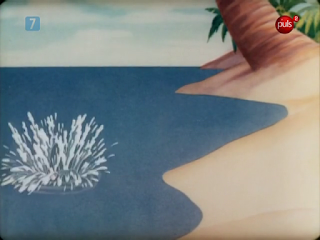


























































































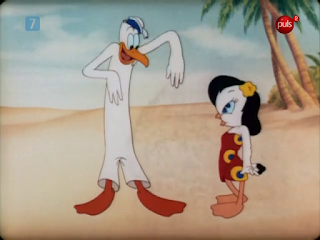
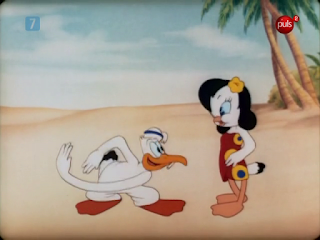






















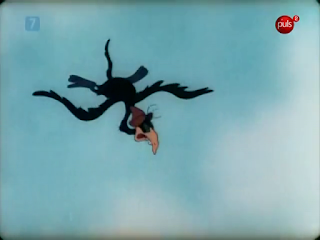


















































































































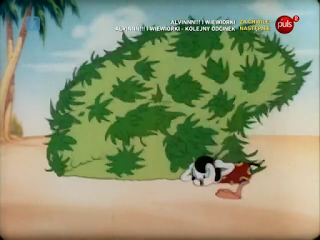




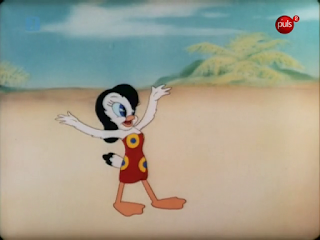

















Colvig's voice and Avery's use of Cecil Crow puts him somewhere between the more innocent stylings of Disney's Goofy that Pinto's dumb voice is permanently associated with, and the Avery-Colvig hyper-sexed country wolf of "Little Rural Riding Hood" eight years later.
ReplyDeleteMeanwhile, the bad guy here having no comedic aspect other than his sweatshirt lettering is sort of Tex's requiem for the type of cartoon he personally destroyed with the creation of the purely comic villain in "Little Red Walking Hood" four years earlier. Hero defeats bad guy and wins the girl was a cartoon staple for Walt and other studios (and in live action before that) -- Avery uses it here to get us to the end gags of the cartoon, but lets the audience know he knows how old-school the plot device is and makes the 'climactic' fight just a plot device that asks for no emotional involvement by the audience.
Nice work, Frank. Hope you're well.
ReplyDeleteNice work on a neglected cartoon, Frank. Hope you're well!
ReplyDeleteThank you. I am in decent condition and am expecting some good news about my health in December. I hope we all get through the remainder of 2020 intact and that 2021 is smoother going.
DeleteFrank, that's nice to hear..BTW Sara Berner's that sweet Leilani (like in that 1937 Bing Crosby song. btw the two birds remindm me of Crosby and Bob Hope..)
Delete